Stand Mixers vs. Hand Mixers: Which One Should You Buy?
Dotdash Meredith and Yahoo Inc. may earn commission or revenue on some items through the links below.
Both have their pros and cons, though stand mixers can do way more.
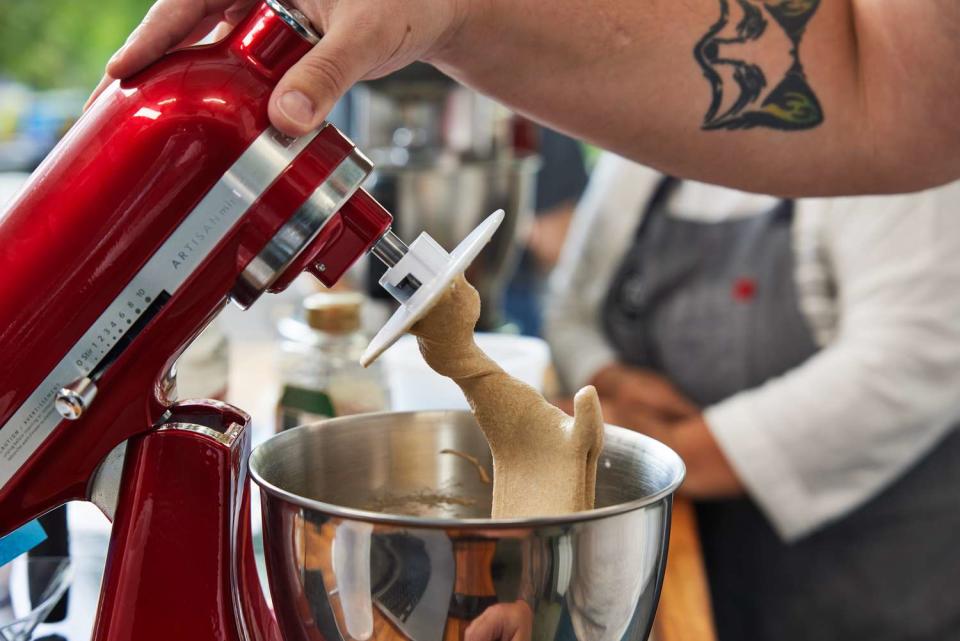
Serious Eats / Russell Kilgore
Our favorite stand mixer is the KitchenAid 6-Quart Professional Series Stand Mixer, while our favorite hand mixer is the Breville Handy Mix Scraper.
Is a stand mixer always better than a hand mixer? At the risk of sounding too internet-y: the answer may surprise you. Stand mixers are an aspirational purchase for many home cooks. With prices that start in the $300s and climb up to the $700s, these countertop appliances are an investment. It makes sense that many cooks end up buying less expensive hand mixers (sometimes called handheld mixers, handheld beaters, or electric beaters) instead. In fact, our top-rated hand mixer is hundreds less than the least expensive KitchenAid stand mixer.
Of course, more than price should be considered when making a big kitchen appliance purchase. You should also look at its versatility, the amount of storage space available in your kitchen, and how (and how often) you plan on using it. Although we pretty much always recommend stand mixers over hand mixers for their sheer versatility, they may not be the right choice for every cook.
Hand Mixers: The Pros
Breville Handy Mix Scraper Hand Mixer

KitchenAid 9-Speed Digital Hand Mixer with Turbo Beater II

Hand mixers are designed to be motored around a mixing bowl by hand (no surprise there). Because they must be small and light by design, you won’t have trouble finding a spot to tuck them away when not in use. In contrast, stand mixers are so big and heavy, many cooks opt to keep them on the counter rather than finding dedicated storage space. The Breville Handy Mix Scraper Hand Mixer is a petite four pounds. Our runner-up, made by KitchenAid (yep, that KitchenAid) is just half that.
Unlike stand mixers, you can use hand mixers in almost any mixing bowl; rubber guards on the beaters will keep bowl materials (like ceramic) from becoming scratched or nicked. Hand mixers are also easy to maneuver around. You can tilt and adjust the angle of the beaters to scrape at the side of the bowl as you go. In contrast, with a stand mixer, you’ll need to turn off the motor, lift the attachment, and use a spatula to push things down the bowl's sides periodically when mixing.
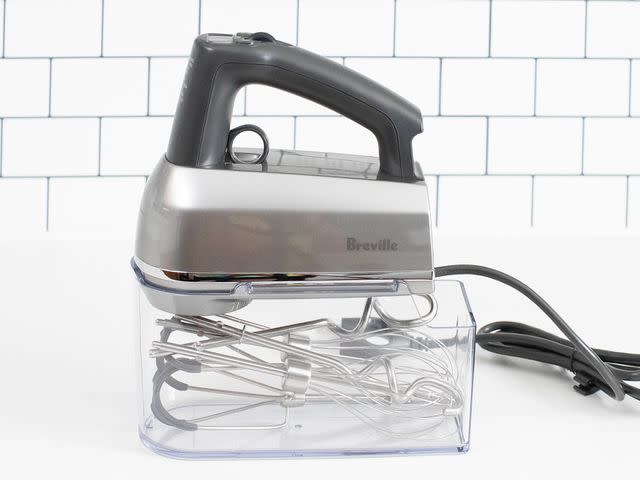
Serious Eats / Donna Curie
Of course, there are a few bells and whistles we really like about hand mixers: the best of the best are impressively quiet, with decibel ratings in the 70s. We also like models with built-in timers, so you can see how much time has elapsed while mixing. That’s not a feature even the snazziest stand mixers have.
Newer models of hand mixers do boast more versatility than those of yesteryear, although we remain skeptical of how much better than hand-kneading dough the hook-style attachments are.
Stand Mixers: The Pros
KitchenAid Professional 600 Series 6-Quart Bowl-Lift Stand Mixer

To borrow (and slightly alter) a line from musical theater canon: “Anything a hand mixer can do, a stand mixer can do better.” Just like hand mixers, stand mixers can whisk and beat egg whites, heavy cream, and cookie dough. But they’re much more powerful. Our favorite stand mixer, the KitchenAid 6-Quart Professional 600 Series, has a 575-watt motor, and that’s not even the highest powered model in KitchenAid’s fleet. The Breville Handy Mix, our top hand mixer, peaks at just 240 watts. More wattage generally means a more powerful appliance.
Of course, a stand mixer already offers your arms a rest: whatever model you choose, its attachments work independently of the cook. But like self-driving cars, these appliances aren’t fully independent. Some stand mixers “walk” across the counter at higher speeds, and should be monitored when in use.
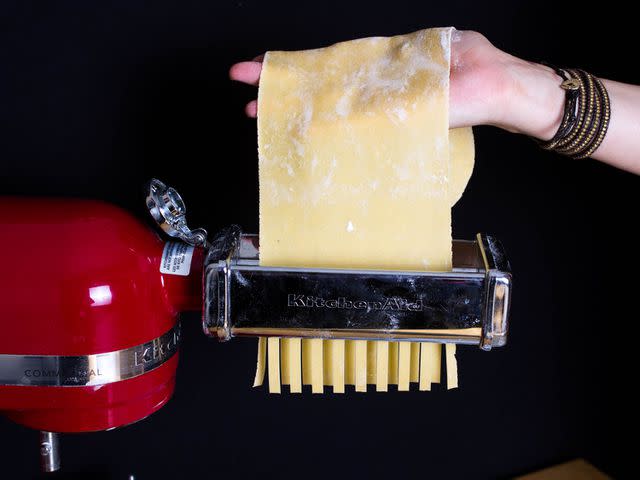
Serious Eats / Vicky Wasik
The versatility a stand mixer offers is often what seals the deal for cooks on the fence. Most models come standard with a whisk, paddle, and dough hook attachment. With those three tools alone, you could knead bread dough, whip up a batch of cookies, and make an American buttercream frosting. Once you’ve gotten comfortable with the machine, you may choose to invest in additional attachments: pasta makers and meat grinders are two popular options that up the ante for from-scratch kitchen enthusiasts.
Read More:Which KitchenAid Stand Mixer Should You Buy? We Compared (Almost) All of Them
The visual appeal is hard to ignore, too. Although there are certainly other brands of stand mixers, the presence of a colorful KitchenAid on the counter is eye-appealing. And of colors, there are plenty: depending on the model you choose, KitchenAid offers dozens of hues, including limited release options (in 2023 it’s a deep pinky-red Hibiscus).
Hand Mixer vs. Stand Mixer: What Can You Use Each For?
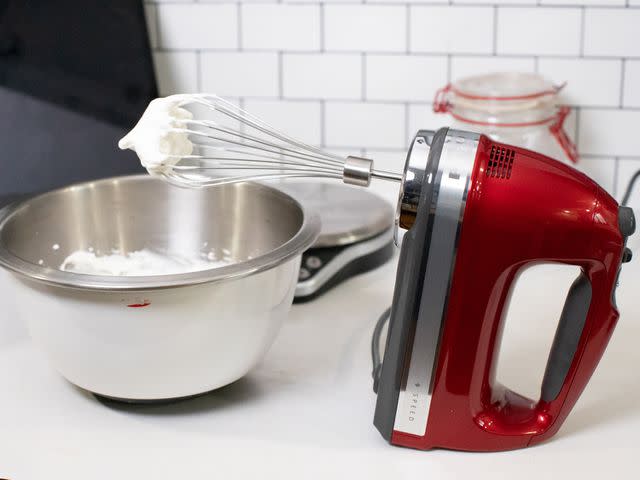
Serious Eats / Donna Currie
Brass tacks: when can—and can’t—you use each appliance? In general, stand mixers can do more than hand mixers, thanks to their larger and more versatile attachments, and higher wattage.
Hand Mixer: Yes
Whip cream
Whip egg whites
Cream butter and sugar
Make buttercream frosting
Can be used in almost any mixing bowl
Hand Mixer: No
Knead bread dough (unless a specific attachment is used, but we’re still doubtful)
Make pasta dough
Grind meat
Stand Mixer: Yes
Whip cream
Whip egg whites
Cream butter and sugar
Make buttercream frosting
Knead bread dough
Make pasta dough
Grind meat
Stand Mixer: No
Not highly portable
Some model may struggle with small ingredients
Which Is Better: Stand Mixers or Hand Mixers?
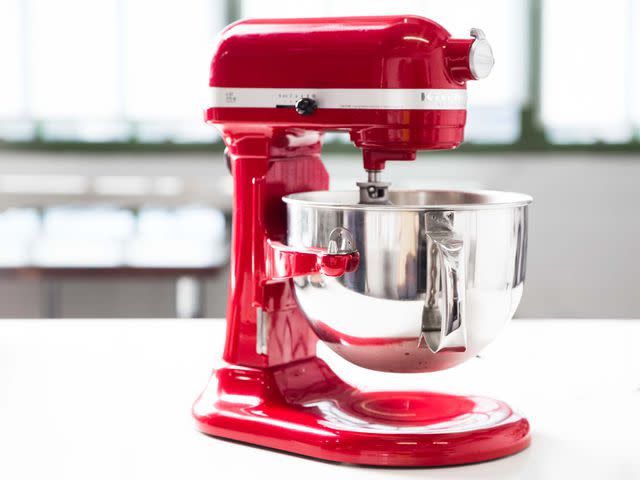
Serious Eats / Vicky Wasik
If you have the space and budget, we recommend buying a stand mixer. They are a true investment purchase that will last you years to come. If the price is a limiting factor for you, you may consider buying a refurbished model (purchasing directly from KitchenAid ensures working quality). However, Iif you plan on using your electric mixer for just the basics—whipped cream and egg whites, with the occasional batch of cookies tossed in—a hand mixer will do the job.
FAQs
What is an electric mixer?
Both stand and hand mixers are categorized as electric mixers. That means they’re powered with a small motor that runs on electricity. At its most basic, an electric mixer—sometimes called an electric beater—is a souped up version of a handheld whisk. Electric mixers, whether they’re handheld or standalone, are fitted with whisk-like attachments that can whip, mix, and cream ingredients for recipes like whipped cream, sugar cookies, and meringue. Both stand mixers and hand mixers come with a variety of different attachments, although stand mixers are more versatile, can accommodate larger batches of food, and offer more uses.
What’s the best stand mixer?
Our favorite brand of stand mixer is KitchenAid. KitchenAid stand mixers come in three different models: the Professional, Artisan, and Classic series. There’s plenty to appreciate about each style, but we overwhelmingly prefer the Professional Series. The best stand mixer according to our tests is the KitchenAid 6-Quart Professional 600 Series Stand Mixer. It’s stationary and doesn’t walk when kneading dough. We especially like the design of the mixing bowl, which doesn’t have a foot (this means it can be used over a flame, or double-boiler, as required for some recipes). The wide design of the bowl makes it a cinch to scrape down when working.
What’s the best hand mixer?
The best hand mixer is the Breville Handy Mix Scraper Hand Mixer. It comes with three sets of attachments, is fitted with a focus light, and has nine speeds for precision mixing. We also liked the KitchenAid 9-Speed Digital Hand Mixer, which is quieter and lighter (if a little less powerful). When shopping for a hand mixer, look for models with a high range of speed options and that are quiet. Comfortable, ergonomic designs are also key, as you may be holding it for minutes at a time.

